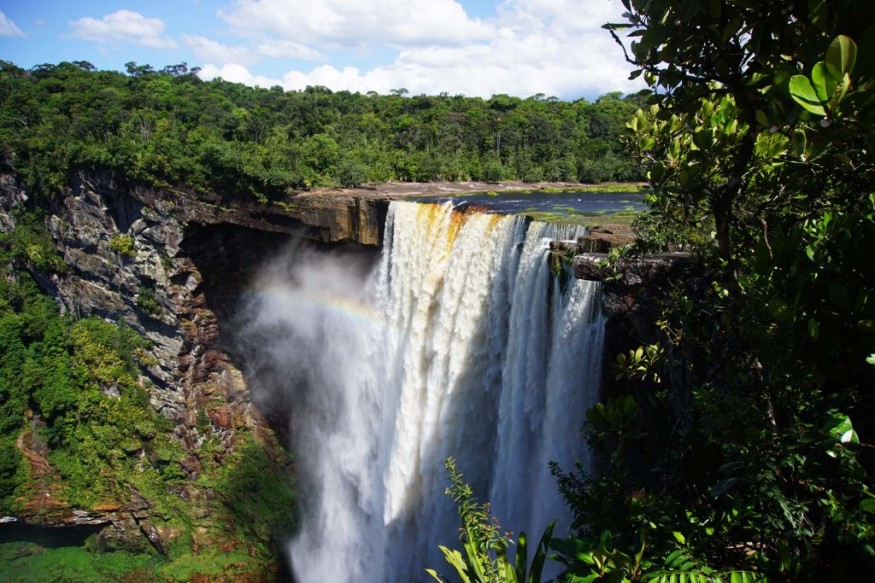Guyana: 5 Most Beautiful Places to Visit in the South American Country

Guyana is reportedly one of the few remaining countries largely untouched by humans. Its wild beauty is second to none. Guyana has a population of slightly under 800,000 people, with 90% of the population living around the shore.
Tropical rainforests still cover more than two-thirds of Guyana. It is the only English-speaking country in South America with a long Atlantic coastline (450 miles) and borders Venezuela, Brazil, and Suriname.
READ NEXT : Taste of Guyana
5 Most Beautiful Spots in Guyana
With colonial influences from the Netherlands, Britain, and France, beautiful post-colonial urban centers, and a wild and undisturbed backcountry ranging from mist-topped tepuis to untamed virgin rainforests, it is no wonder there is so much to see and do in Guyana. Here are five of the most beautiful places to visit in the South American country.
Kaieteur Falls
South America is home to some of the world's most spectacular waterfalls, including Guyana's Kaieteur Falls, which has the world's highest single drop. According to Oceanic Society, Kaieteur is about five times as tall as Niagara, with a plunge of 740 feet.
A special bromeliad microclimate is supported by the almost 23,000 cubic feet of water per second cascading over the falls. Water-filled leaves provide a permanent home for little golden frogs. This one of the most peaceful Guyana tourist spots is frequently empty as it only receives about 3,000 tourists yearly.
Shell Beach
Shell Beach is, without a doubt, the most well-known beach in Guyana. It can be found on a salt-sprayed stretch of the coast, where the Atlantic waves meet the Caribbean currents offshore, and the mangroves sprawl and creep over the sands to the shore.
But, visitors do not come here to swim and sunbathe. Being one of the top Guyana tourist spots for nature lovers, visitors travel here to witness the annual turtle nesting phenomenon, which takes place from the end of March until the end of August.
This phenomenon attracts various sea turtle species, including leatherbacks, hawksbills, olive ridleys, and greens. The unspoiled beaches and lagoons of South America are waiting to be explored, and so is the opportunity to visit traditional towns and bamboo huts dotting the landscape.
Mount Roraima
Mount Roraima is a flat-topped mountain that juts up like an oblong slab of chiseled stone at the tripoint of the borders of Venezuela, Brazil, and Guyana. It is one of the most stunningly beautiful South American tepuis, The Crazy Tourist reported. The mountain's origins date back to the Precambrian epoch, over two billion years ago, making it one of the world's oldest geological formations.
It rises straight up 400 meters from the grasses and woods below. The plateau's peak presents a formidable task to even the most seasoned hikers and mountain climbers. Still, those who make the ascent will be rewarded with a veritable treasure trove of unique pitcher plants, algae, reptiles, and amphibians that live there in peace, safe from the dangers of the lower plains.
Kamarang
Kamarang, deep in western Guyana, is hidden by thick swaths of tropical jungle. The isolated and relatively inaccessible location was formerly only a modest Indigenous tribal community on the edge of the rugged Pacaraima Mountains, which rise in stepped rock terraces and table-topped bluffs throughout the region, forming the bulwark of rock that is today the boundary with Venezuela.
The most common way to reach here is by private charter plane. Kamarang has become a boomtown in recent years due to its reputation as the site of some of Guyana's most valuable mineral and gold deposits. The nearby Kamarang Great Falls, which is incredibly impressive but relatively unknown to tourists, also makes it one of the places to visit in Guyana and a tourist hotspot on the rise.
Iwokrama Rainforest
The lowland tropical forest of Iwokrama forms a large, protected wilderness area. Boat rides and guided hikes allow visitors to get up and personal with black caimans and avian wonders like the Guianan cock-of-the-rock and scarlet macaw, per Wildlife Worldwide.
The Iwokrama environment, at the crossroads of the Amazonian and Guyanese biomes, is home to several endangered or extinct animals over much of their former range, such as the giant anteater. More than 420 kinds of fish and 90 species of bats have been discovered here, making it the most diverse region in the world.
In addition to its exceptional avian variety of more than 500 species, it is also a global hotspot for numerous plant groups, notably the Lecythidaceae and the Chrysobalanaceae. The percentage of people who have seen jaguars in the wild at either dawn or dusk is exceptionally high in Iwokrama, making it one of the best places to visit in Guyana to see these elusive animals.
READ MORE : Explore Nicaragua's Culture
This article is owned by Latin Post.
Written by: Bert Hoover
WATCH: Mysterious Islands in the Sky Unlock Secrets of Our Past: Return to Tepuis - From National Geographic
Subscribe to Latin Post!
Sign up for our free newsletter for the Latest coverage!

















